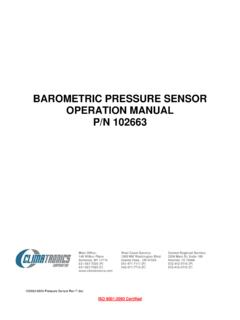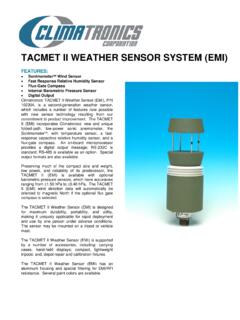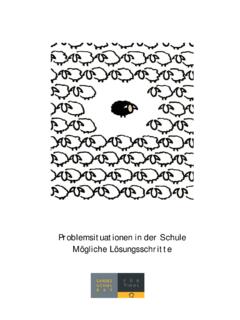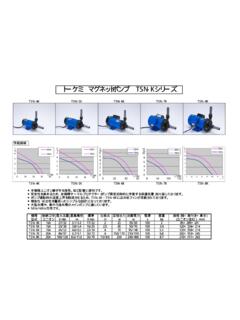Transcription of MANUAL - F460 CROSSARM P/N M101994 REV B
1 INTRODUCTION The f460 CROSSARM is a completely prewired unit that allows easy mounting and servicing of the f460 Wind Speed and Direction Sensors. Adapters mounted on either end of the CROSSARM are keyed with the transmitters to assure that the sensors cannot inadvertently be reversed. INSTALLATION Mounting of the CROSSARM is easily accomplished by sliding the center adapter over the appropriate pipe and tightening the set screws with an Allen key. In order to obtain accurate wind direction readings, it is necessary to orient the wind direction sensor with relation to either true north or magnetic north. Most air quality type monitoring requires wind direction relative to true north. Most aeronautical applications require wind direction relative to magnetic north.
2 The CROSSARM is aligned at the factory so that the wind direction sensor will indicate correctly if the CROSSARM is oriented in the north-south axis with the wind direction sensor on the south end (see Figure 1). Note that the mounting adapter on the wind direction end of the CROSSARM has a scribe mark. This scribe mark is aligned exactly in a parallel plane to the CROSSARM if the factory alignment has not been changed. If physical restrictions do not allow the CROSSARM to be oriented in the north-south plane, it is possible to move the wind direction mounting adapter located in the end of the CROSSARM so the wind direction sensor can be oriented independently of the CROSSARM orientation. A CROSSARM sighting device, P/N 101126, is available to facilitate alignment of the wind direction mounting adapter.
3 NORTHSOUTH FIGURE 1 Finding True North There are two methods commonly used to find true north. Compass Method To find the correct True North orientation of a site, one must first find the magnetic angle of declination. Several sources contain this information, such as topographic or aeronautical navigation maps of the area. For example, Bohemia, New York, which is located on the eastern coast of the United States, has a magnetic angle of declination of approximately 13 degrees west. This indicates that magnetic north is 13 degrees west of True North. In this case, 13 degrees would be added to 360 degrees. The resultant, True North reading if a compass reading were taken along the CROSSARM would be 13 degrees.
4 Moving to the west coast Seattle, Washington, has declination of approximately 22 degrees east. This indicates that magnetic north is 22 degrees east of True North. For this reading, 22 degree should be subtracted from 360 degrees. A compass reading along the CROSSARM in Seattle should read 338 degrees for True North-South orientation. When a CROSSARM has been properly aligned, the wind speed sensor end should be oriented north while the wind direction sensor end should be facing south. True Solar Noon Method The True Solar Noon (TSN) method finds the time at some particular date at some particular longitude when the sun is in the north-south plane passing through the North Pole, the South Pole and the longitude selected.
5 If the sun is not directly overhead (elevation 90 ), the azimuth line to the sun is TRUE SOUTH or TRUE NORTH . Two calculations are required. First, find the time of the Local Apparent Noon (LAN) from the longitude. The examples shown here are for: MANUAL - f460 CROSSARM P/N M101994 REV B SENSORS CLIMATRONICS CORPORATION (631) 567-7300 Fox Island, WS (Long. , Lat. ), 07/04/90 and New Orleans, LA (Long. , Lat. ), 12/25/90 TLAN = 12:00:00 + 4 (long. - 15n), where n is the number of time zones from Greenwich. See Figure 2 for a list of n values for United States time zones. TLAN (WA) = 12:00:00 + 4( - [15 x 8]) = 12 = 12:10:31 PST TLAN (LA) = 12:00:00 = 4( - [15 x 6]) = 12 = 12:00:26 CST Secondly, correct for the ephemeris of the sun.
6 TTSN = TLAN - A, where A is the correction found in Figure 3. TTSN (WA) = 12:10:31 - (-4:16 = 12:14:47 PST = 13:14:47 PDT TTSN (LA) = 12:00:26 - (-0:08) = 12:00:34 CST Once the time of TSN is known, all that remains is to observe the position of the line to the sun at TSN. An easy way is to use a loosely mounted theodolite set at 180 to track the sun. CAUTION !! Eye damage may result from looking at the sun without suitable protection. Remember that harmful UV rays can be present when visual light "looks" safe. Use an eye safe filter. When a watch (one second resolution set to WWV or equivalent source for the correct time) shows TSN, tighten the theodolite mounting. At that instant the sun is in the cross hair of the theodolite and the theodolite correctly labels the azimuth angle at 180.)
7 Once set, the theodolite can be used to find the bearing to any distant feature which might be selected as an orientation target. Another method is to mark the end of the shadow of a vertical tower at TSN, thus establishing a North-South line from the base of the tower to the mark. The two drawbacks to the TSN method are weather and schedule. If the sun is obscured at TSN the observation cannot be made. Also if other activities command higher priorities, the time of TSN might not be available for the sighting. 1 Environmental Protection Agency, Office of Research and Development, Quality Assurance Handbook for Measurement Systems, Section No. Verification After the CROSSARM and sensors have been installed, it is advisable to verify the proper operation and orientation of the wind direction sensor.
8 The wind direction sensor vane should be pointed at the north and south orientation targets that have been found using the methods described in Section 2. The wind direction recorded on the data collection equipment being used should be within the allowed accuracy tolerance. In addition, the wind direction sensor should be pointed at east and west to ensure that no wiring errors have been made that might cause erroneous readings. If the wind direction sensor uses 540 degree circuitry, this should be checked by rotating the wind vane from west to east through north and observing that the wind direction output goes into the 540 degree region. INPUT/OUTPUT CONNECTIONS PIN FUNCTION A Ground B +V In C WS Frequency Output D Pot Ground E Pot +V F WD Out USER-DEFINED OPTIONS The CROSSARM can be configured in three ways: 101994-G0 - Designed to mount on 3/4" pipe 101994-G1 - Designed to mount on 1" pipe 101994-G2 - Designed to mount on 1 1/4" pipe USER INTERFACE Not Applicable THEORY OF OPERATION Not Applicable CALIBRATION Not Applicable CLIMATRONICS CORPORATION (631) 567-7300







